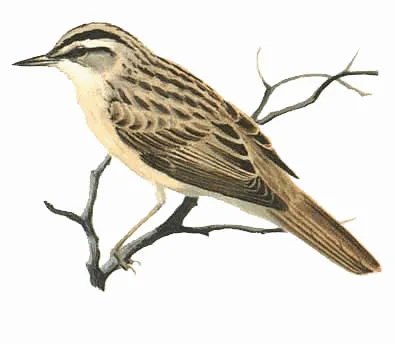
Aquatic Warbler
[order] PASSERIFORMES | [family] Acrocephalidae | [latin] Acrocephalus paludicola | [UK] Aquatic Warbler | [FR] Phragmite aquatique | [DE] Seggen-Rohrsanger | [ES] Carricerin Cejudo | [NL] Waterrietzanger
Subspecies
Monotypic species
Physical charateristics
Small, heavily streaked, buff-and-black warbler. Strong black streaking on mantle bordered by pale “tramlines”. Pale coronal stripe with black border. Pale lores. Streaked back, rump and uppertail-coverts. Finely streaked breast. Similar spp. Sedge Warbler A. schoenobaenus generally browner and less streaked. Lacks strongly streaked mantle and pale “tramlines”, pale coronal stripe and streaks on breast. Song more complex and varied with mimicry and distinctive sweet notes. Voice Series of simple trills and short whistles, given from vegetation or short song flight. Does not mimic extensively. Low tuk or dry churr call.
Listen to the sound of Aquatic Warbler
[audio:http://www.aviflevoland.nl/sounddb/A/Aquatic Warbler.mp3]
Copyright remark: Most sounds derived from xeno-canto
| wingspan min.: | 17 | cm | wingspan max.: | 19 | cm |
| size min.: | 12 | cm | size max.: | 15 | cm |
| incubation min.: | 12 | days | incubation max.: | 15 | days |
| fledging min.: | 13 | days | fledging max.: | 15 | days |
| broods: | 2 | eggs min.: | 3 | ||
| eggs max.: | 7 |
Range
Eurasia : Central, East Europe
Habitat
It breeds in lowland marsh habitats (mostly sedge fen mires) with water less than 10 cm deep1. It winters in similar habitats and, on migration, favours low stands of sedge and reed near open water.
Reproduction
Central and eastern Europe egg laying from early May to late July. Usually 1-2 broods. Nest built in dense vegetation (usually old sedge clump) over swampy ground or water. Mean height above surface: 17.0 cm (3-30). Nest is a neatly but rather loosely constructed cup of grass, plant stems and leaves, spiders? webs, and plant down, lined finer material; usually with roof, and more like nest of Reed Bunting than typical Acrocephalus. Clutch: 4-6 (3-8), incubated for 12-15 days. Chicks fledge after 13-14 days.
Feeding habits
Predominantly insects. Taken almost exclusively while climbing or scurrying about in dense, low vegetation, though also recorded on warm autumn days feeding agilely higher up in (e.g.) bushes of willow.
Conservation
The Aquatic Warbler has suffered a dramatic decline in the EU, mainly in central Europe. The current breeding population is unlikely to excess a hundred pairs. The causes of this decline are the frequent loss of nesting habitat, mainly due to land drainage associated with agricultural development and the cessation of traditional hand-scything, resulting in the expansion of dense reedbeds and scrubs wich are unsuitable for the species. Acrocephalus paludicola breeds across a highly fragmented range in (numbers are of singing males) Hungary (6001), Poland (2,900-3,000), Belarus (7,300-13,0003), Ukraine (2,400-3,4001), Russia (10-500 in European Russia, possibly 2,000-11,000 in western Siberia1), Germany (40-50) and Lithuania (250-4001). It is thought to winter in sub-Saharan west Africa, but the wintering range is poorly known. Two-thirds of the known population has been discovered since 1995, and the total population, excluding potential west Siberian breeders, is estimated at 13,500-21,000 singing males1. Since 1970, it is likely to have declined significantly as a result of destruction of 80-90% of its habitat in the river systems of upper Pripyat, Yaselda and Biebrza/Narew. These systems hold approximately 75% of the European population.

Migration
Locally scarce summer migrant of western Palearctic, from eastern Germany and Poland east across western and central Russia to western Siberia and south to Hungary. Winters in subtropical to tropical climatic zones of West Africa. (Baker K 1997)
Local summer visitor Germany, Poland, Czechoslovakia, ? Austria (has bred), Hungary, Romania, European USSR; winters west tropical Africa (wintering grounds little known). Scarce migrant UK, Channel Is., France (has bred), Belgium (has bred), Netherlands (has bred), Germany (formerly bred), Switzerland, Italy. Vagrant Eire (12), Spain (44), Luxembourg, Denmark (15), Norway (6), Sweden (17), Finland (3), Malta, Romania (outside breeding areas), Yugoslavia (may breed), Greece, Bulgaria, Turkey, Cyprus, Jordan, north-west Africa, Canary Is., Azores. (Parmenter T Byers C 1991)
Local summer visitor Germany, Poland, Czechoslovakia, ? Austria (has bred), Hungary, Romania, European USSR; winters west tropical Africa (wintering grounds little known). Scarce migrant UK, Channel Is., France (has bred), Belgium (has bred), Netherlands (has bred), Germany (formerly bred), Switzerland, Italy. Vagrant Eire (12), Spain (44), Luxembourg, Denmark (15), Norway (6), Sweden (17), Finland (3), Malta, Romania (outside breeding areas), Yugoslavia (may breed), Greece, Bulgaria, Turkey, Cyprus, Jordan, north-west Africa, Canary Is., Azores. (Parmenter T Byers C 1991)
Distribution map

